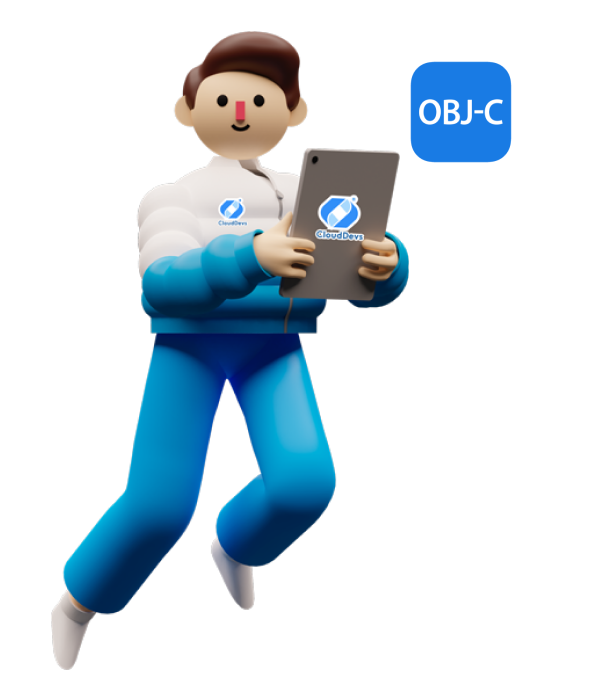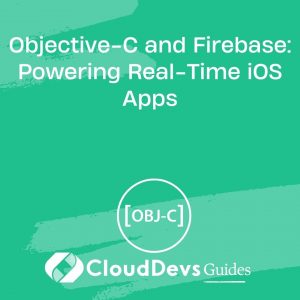Hire Senior Objective-C Developers within 24 Hours
CloudDevs offers a complete solution for recruiting top-tier Objective-C developers, granting access to a reservoir of over 8000 highly-evaluated senior experts. Our platform guarantees seamless teamwork and specialized knowledge by providing exclusive entry to elite Objective-C developers within your local time zone. With CloudDevs as your partner, you can confidently construct resilient and scalable applications using Objective-C, harnessing the expertise and proficiency of our skilled Objective-C developers.
With a 7 day risk free trial

Our Objective-C Developers
Our top talents come from world leading companies
Arildo
Senior Objective-C Developer Ex-Bosch Engineering Latin America


Vinícius
Senior Objective-C Developer Ex-CI&T


Roberto
Senior Objective-C Developer Ex-Picpay


Bruno
Senior Objective-C Developer Ex-Firjan


Humberto
Senior Objective-C Developer Ex-Tekton Labs


Raúl
Senior Objective-C Developer Ex-Crossover For Work


Wellington
Senior Objective-C Developer Ex-IBM


Jorge
Senior Objective-C Developer Ex-Gorila




Melissa B
Founder


Jason Dong
Co-CEO, Founder

Anthony E
Co-Founder
How to Hire Objective-C Developers
through CloudDevs?
3 easy steps to hire Objective-C developers in 24 hours



What is Objective C?
Objective C is a programming language that was developed in the early 1980s and has historically been used to create software and applications for Apple’s macOS and iOS operating systems. It was the primary programming language used for macOS and iOS development before the introduction of Swift, which is now the preferred language for developing applications on Apple platforms.
Objective C is an object-oriented programming language, which means it revolves around the concept of objects, encapsulation, and inheritance. It extends the C programming language with object-oriented features, making it possible to write programs that are modular, organized, and easier to maintain.
One of the notable aspects of Objective C is its dynamic runtime environment. This means that much of the behavior of the program is determined at runtime, allowing for features like message passing to objects, which enables the ability to add or modify methods during runtime.
While Swift has largely replaced Objective C as the primary programming language for Apple development due to its modern syntax, performance improvements, and safety features, Objective C code still exists in many legacy applications and libraries. Understanding Objective C can be valuable for developers maintaining or working with older codebases.
Do companies still use Objective C?
Some companies still use Objective C in 2023, especially those with older iOS and macOS applications and codebases. Objective C was the predominant programming language for Apple development for many years, and there are still a significant number of apps and projects written in Objective C that continue to be maintained and updated.
Companies with legacy apps, large codebases, or applications that were developed before Swift was introduced may still have a considerable amount of Objective C code. Transitioning a large and complex codebase to a new programming language like Swift can be a substantial undertaking, so some companies might opt to continue using Objective C for maintenance and incremental updates.
However, it is worth noting that Swift has gained significant popularity since its introduction in 2014 due to its modern syntax, performance benefits, and safety features. Many new projects and applications are now developed in Swift. Apple’s emphasis on Swift as the future of its development ecosystem has led to a decline in new Objective C projects being started.
Hence, while the adoption of Swift has become the norm for new development, Objective C is still used by companies to maintain and update existing applications and codebases.
Is Objective C worth learning in 2023?
As of 2023, the relevance of learning Objective C has diminished within the realm of Apple app development. Swift, introduced by Apple, has gained significant traction as the preferred language for iOS and macOS app development due to its modern features, enhanced safety, and better performance. While some legacy codebases might still use Objective C, the demand for new Objective C development roles has been steadily declining in favor of Swift. It’s crucial to consider the changing landscape when deciding whether to invest time in learning Objective C.
The job market reflects this shift as well. Job postings for Objective C roles have seen a noticeable decrease, while Swift-related roles have become more prevalent. Companies are keen on hiring developers who are proficient in Swift, given its advantages in terms of code readability, maintainability, and alignment with modern programming practices. Learning Swift not only aligns better with current industry demands but also offers a more intuitive learning curve due to its design as a modern programming language.
When making decisions about skill acquisition, it’s important to think about the long-term investment. Learning Objective C might have limited utility in new app development projects, as companies are focused on Swift for its benefits in terms of both developer productivity and application performance. Swift also benefits from a robust ecosystem, abundant learning resources, and ongoing updates, ensuring its relevance and support in the years to come. While it’s not entirely impractical to have Objective C knowledge, choosing to invest time in learning Swift is likely a more strategic choice for individuals aiming for career growth in Apple app development.
Will Swift replace Objective C?
Swift, introduced by Apple in 2014, has already made substantial strides in replacing Objective C as the primary programming language for iOS and macOS app development. Swift was designed to modernize and improve upon the shortcomings of Objective C. Its syntax is more concise and readable, it incorporates modern programming paradigms, and it offers enhanced safety features that reduce the likelihood of common programming errors. As a result, Swift has gained rapid adoption within the developer community, and Apple actively promotes its use.
While Objective C remains relevant in maintaining legacy codebases and in specific scenarios, the trend is unmistakably shifting towards Swift. Apple’s emphasis on Swift development is evident in its continual updates to the language, integration into new APIs, and the provision of modern development tools. As Swift continues to evolve and mature, more developers are transitioning away from Objective C to embrace the benefits and future-proofing that Swift offers. In light of these developments, it’s reasonable to expect that over time, Swift will continue to replace Objective C as the dominant language for Apple platform development.
Why does Apple still use Objective C?
Apple’s continued use of Objective C can be attributed to a combination of legacy codebases, compatibility concerns, and incremental adoption of Swift. Many of Apple’s older apps, frameworks, and libraries were built using Objective C. Migrating these extensive codebases to Swift could be a complex and resource-intensive process. As a result, Objective C remains in use to maintain and update these existing apps, ensuring their continued functionality and compatibility.
Moreover, Apple recognizes that transitioning fully to Swift would impact developers and businesses that have invested heavily in Objective C. The coexistence of both languages allows developers to work with the language they are most comfortable with, particularly when dealing with older projects. This approach provides a smoother transition path and allows Apple to maintain support for its existing developer community.
Apple’s measured approach to adopting Swift is also influenced by its commitment to stability and minimizing disruption. Swift has undergone rapid development since its introduction, with each version bringing enhancements and refinements. Apple’s gradual integration of Swift into its ecosystem ensures that developers can benefit from the language’s advantages while avoiding drastic changes that could impact workflows and applications. In this way, Apple balances innovation with maintaining a stable environment for developers and users alike.
Can you make iOS apps with Objective C?
Objective C has been the traditional programming language for iOS app development, preceding the introduction of Swift. Many of the apps available on the App Store were built using Objective C, and it has been the go-to language for Apple development for many years. This means that developers familiar with Objective C can create fully functional and feature-rich iOS applications.
Objective C provides access to all the APIs and frameworks available for iOS development, enabling developers to build powerful and sophisticated apps. Although Swift has gained popularity due to its modern syntax and enhanced safety features, Apple continues to support and maintain Objective C to ensure that developers can work with the language they are comfortable with. This is particularly relevant for maintaining and updating existing Objective C projects.
As of now, both Objective C and Swift are viable options for iOS app development. The choice between them often depends on factors such as the developer’s familiarity with the language, project requirements, and whether the app is built from scratch or involves working with legacy codebases. While Swift is the recommended language for new projects due to its modern features, Objective C remains an essential tool for maintaining and extending existing iOS applications that were originally written in the language.
What apps are written in Objective C?
-
Apple’s Apps: Many of Apple’s apps, such as the App Store app, were originally developed using Objective C.
-
Twitter: The Twitter app for iOS was initially written in Objective C before being migrated to Swift.
-
Instagram: Instagram’s early versions were also written in Objective C before later adopting Swift for development.
-
WhatsApp: WhatsApp, a widely used messaging app, was originally developed using Objective C.
-
Facebook: Facebook’s iOS app was initially written in Objective C, although parts of it have been rewritten in Swift over time.
-
LinkedIn: LinkedIn’s iOS app was originally developed in Objective C.
-
Evernote: The popular note-taking app Evernote was initially written in Objective C before transitioning to Swift for certain parts of its codebase.
-
Dropbox: Dropbox’s iOS app was also developed using Objective C.
-
Skype: Skype’s early versions for iOS were written in Objective C.
-
Shazam: The music recognition app Shazam was originally developed in Objective C before Apple acquired it and likely transitioned some parts to Swift.
What companies use Objective C?
Objective C serves as Apple’s primary programming language, facilitating the creation of the prominent OS X and iOS operating systems, both highly favored by users. This versatile language amalgamates C with a messaging system akin to Smalltalk. The language’s enduring presence is underscored by its numerous impressive attributes and capabilities. This assertion gains further credence from its adoption not only by Apple but also by numerous contemporary industry giants.
-
Instagram
Instagram stands out as a prominent illustration of a renowned enterprise harnessing Objective C. Initially introduced in 2010, the Instagram application debuted on Apple’s iOS platform, enabling users to distribute photos and videos seamlessly. Presently, it stands as one of, if not the most, globally acclaimed social media platforms.
Individuals registered on the app can upload files, apply diverse filters to modify them, and subsequently distribute the edited renditions publicly or exclusively to their followers. Moreover, users of Instagram now possess the ability to incorporate multiple media elements into a solitary post and engage in conversations through its integrated messaging feature.
-
Uber
Uber specializes in offering transportation solutions and operates across approximately 72 countries globally. Depending on the specific location, customers can access diverse services tailored to their requirements. For instance, in regions where motorcycles are a prevalent mode of transportation, Uber offers the option of riding bicycles. Additionally, Uber extends its offerings to encompass food delivery services through subsidiaries like Uber Eats.
Individuals who have registered with Uber gain the convenience of booking and scheduling rides directly through the mobile app. The app also provides supplementary details such as projected travel duration and the proximity of the user to the driver.
-
Pinterest
Pinterest, often recognized as a platform for saving favorite images, extends beyond simple photo collection. While its primary function involves curating visual content, it has evolved into more than just a pinboard. In the contemporary landscape, Pinterest is undergoing growth as both a social networking tool and a creative space for written content.
Presently, Pinterest stands out as a prominent hub for image sharing and fostering connections among individuals. Users engage with a diverse array of content including images, GIFs, and videos, all of which can be stored on personalized virtual pinboards. Essentially serving as a digital repository for ideas, Pinterest enables users to interact with “pins,” which encompass multimedia sourced from websites. Each user has the autonomy to create custom boards and explore pins, thereby discovering novel concepts, individuals, and aesthetics.
-
Slack
Running a successful business while relying heavily on communication methods like email and WhatsApp might not yield optimal results. This is where the potential utility of Slack comes into play. Despite not being overly burdened with excessive features that could hinder performance, Slack boasts a range of exceptional functionalities. For companies aiming to establish effective connections with their audience, this platform could prove invaluable.
Slack functions as a tool for business communication, offering an assortment of features such as persistent chat rooms categorized by subjects, along with direct messaging that bears resemblance to IRC. Enterprises leverage this tool to provide their workforce with unfettered access to pertinent information, regardless of their location or preferred timing. The predominant mode of interaction on Slack takes place within channels, which serve as discussion spaces centered around specific topics. These channels can be divided into two categories: public, accessible to all, and private, restricted to specific individuals or groups.
-
Snap chat
Snapchat functions as a form of instant messaging app focused on multimedia, allowing users to transmit and receive content within specific time limits. With an impressive user base of around 300 million daily active participants, it facilitates the sharing of media that possesses a finite lifespan. A pivotal driver of Snapchat’s widespread appeal stems from its incorporation of advanced technologies, such as AI-driven filters and lenses.
How media is exchanged through Snapchat served as the foundational concept for the introduction of the “Stories” feature in other instant messaging applications like Instagram and WhatsApp.
What’s the cost of hiring Objective C developers?
The cost of hiring Objective C developers can vary depending on factors such as their experience level, location, and the scope of the project. Generally, hiring Objective C developers from regions with a higher cost of living, like North America or Western Europe, may result in higher hourly or project-based rates. On the other hand, developers from regions with a lower cost of living, such as certain parts of Asia or Eastern Europe, might offer more competitive rates. Additionally, the complexity of the project and the demand for Objective C expertise can influence the cost.
According to Upwork, the hourly rate of an Objective C developer is between $17 to $85.
At CloudDevs, you have the opportunity to onboard a dedicated Objective C developer from Latam at a rate ranging from $45 to $70 per hour, aligning with your local time zone. One of the prominent benefits of recruiting Objective C developers through CloudDevs is the provision of a seven-day complimentary trial period. Should the developer’s performance not meet your expectations, you have the flexibility to engage another developer or request a refund. Our offerings also encompass a pay-as-you-go alternative, enabling you to establish weekly contracts without any obligatory minimum commitment. This arrangement is tailored to your preferences while ensuring that the developers you hire synchronize with your local time zone.
What are the roles and responsibilities of an Objective C developer?
-
Develop and maintain iOS and macOS applications using Objective C.
-
Write clean, efficient, and maintainable code in Objective C, adhering to coding standards and best practices.
-
Collaborate with cross-functional teams, including designers and product managers, to understand requirements and translate them into technical specifications.
-
Implement user interfaces and application features using Interface Builder and Objective C code.
-
Integrate backend services and APIs into applications, handling data transmission and manipulation.
-
Ensure the application’s performance, quality, and responsiveness through rigorous testing and optimization.
-
Identify and fix bugs, bottlenecks, and other issues in the codebase.
-
Work with version control systems like Git to manage code changes and collaborate with team members.
-
Stay up-to-date with the latest iOS and macOS updates, development trends, and industry best practices.
-
Assist in code reviews and provide constructive feedback to team members.
-
Port existing applications from other platforms to iOS/macOS using Objective C.
-
Document code, processes, and decisions to facilitate knowledge sharing and future development.
How to hire Objective C developers?
When you are looking to hire Objective C developers effectively, start by crafting a clear job description that outlines the specific skills, experience level, and responsibilities required for your project. Post the job on relevant platforms like job boards, developer communities, and social media. Look for candidates with a strong background in Objective C development, a portfolio showcasing their past projects, and a proven ability to work on iOS/macOS applications.
During interviews, assess their familiarity with Objective C syntax, memory management, and debugging skills. Evaluate their problem-solving abilities and teamwork through coding tests and scenario-based questions. Prioritize candidates who demonstrate adaptability to evolving technologies and a keen interest in staying updated with iOS/macOS developments.
Table of Contents
Objective-C FAQs
- Mature Ecosystem: Objective C has been around for a long time and has a well-established ecosystem with a wealth of libraries, frameworks, and resources.
- Interoperability: Objective C code can be used alongside Swift in the same project, allowing developers to leverage existing Objective C codebases while adopting new Swift features.
- Dynamic Runtime: Objective C’s dynamic runtime allows for features like method swizzling and dynamic method resolution, enabling more flexible coding practices.
- C Compatibility: Being a strict superset of C, Objective C can directly use C libraries, making it suitable for systems programming and low-level tasks.
- Existing Codebase: If you’re working with legacy codebases or maintaining older apps, Objective C might be the practical choice due to its historical prevalence.
- Learning Resources: As Objective C was widely used in the past, there are many tutorials, books, and online resources available for learning and troubleshooting.
- Cross-Platform Development: While primarily associated with Apple platforms, Objective C can be used for cross-platform development with projects like GNUstep.
Swift has largely replaced Objective C as the preferred programming language for iOS and macOS development. Swift offers modern syntax, enhanced safety features, and better performance, making it the language of choice for new projects and updates. While Objective C is still supported and can be used in existing codebases, Apple’s focus has shifted to Swift for its active development and future innovations.
To find the best remote Objective C developers, explore reputable platforms like GitHub, Stack Overflow, and LinkedIn, where developers often showcase their expertise. Consider using specialized job boards and freelancing platforms like Upwork and Toptal. For a curated pool of skilled Objective C developers, CloudDevs from Latam is a noteworthy option, offering access to experienced talent for your remote development needs.
In order to become an Objective C developer, you will need a solid grasp of programming fundamentals, proficiency in Objective C syntax and Xcode, familiarity with UIKit or AppKit frameworks, and the ability to integrate APIs. A portfolio of projects demonstrating your skills, along with continuous learning and effective communication, are also essential. Consider joining CloudDevs from Latam for access to skilled remote Objective C developers.
Hiring Objective C developers from CloudDevs presents a strategic choice for your development needs. Our platform provides the opportunity to engage dedicated Objective C developers from Latam, offering a skillful resource at a competitive rate of $45 to $70 per hour, aligned with your time zone. One of our standout benefits is the inclusion of a seven-day free trial period. This unique offering ensures complete satisfaction, and hence, if the developer chosen doesn’t meet your expectations, you have the flexibility to select another developer or request a refund. Additionally, CloudDevs offers a pay-as-you-go option, allowing you to conveniently establish weekly contracts without any mandatory commitment. This adaptable approach to hiring complements your project demands seamlessly.
Empower Your Vision with Local Time Zone Objective-C Developers!
Uncover proficient Objective-C developers from our handpicked assembly of over 8000 skilled professionals. At CloudDevs, we bring you a simplified approach to hiring top Objective-C talent, granting you access to adept developers aligned with your local time zone. Craft exceptional applications with confidence, powered by our dedicated Objective-C experts who transform your concepts into reality.















